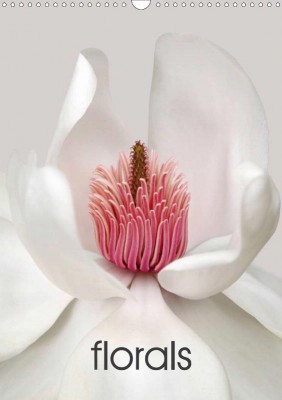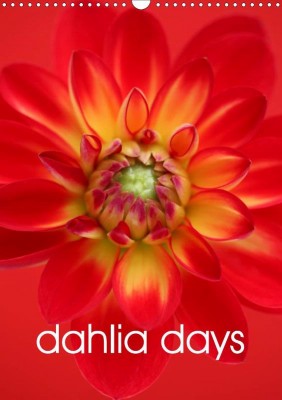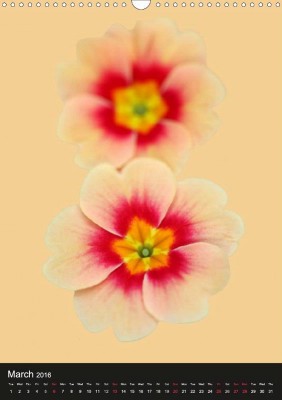With a background in arts and photography, Brian Ross Haslam is applying all his skills in order to create his elegant floral photos. Here, the Devon-based photographer tells us why training with an advertising photographer in London was an eye opener for him plus he reveals some of his personal ‘tricks of the photography trade’. By the way, the photograph you see in the image below (also on the cover of one of Brian’s Calvendo calendars) won second place in the International Garden Photographer of the Year’s Plant Portraits category! It’s a Magnolia campbellii var. “Alba”, just in case you’re wondering. (We were.)
Brian, can you talk a bit about your background as a photographer and how and when you took up photography?
The only ‘A’ level I passed at Torquay Grammar School in 1979 was Art, so Art School seemed the next option. I moved next door to the Technical College to take a one year Art Foundation Course. Here, you have a go at everything including sculpture, pottery, printmaking, jewellery, life modelling, photography, painting and drawing. I then applied to Exeter for Fine Art, Brighton for Graphics, and Bournemouth for Photography and Film. Luckily, I was accepted at Bournemouth for a three year Diploma Course. Nick Knight, the renowned fashion and documentary photographer, was in the year above me and always in another league.
After graduating, some of us gravitated to London to look for assisting work and advertising photographer Paul Windsor took me on as assistant which was an eye opener. His equipment ran from Nikon to Hasselblad to Mamiya and to Sinar for 5×4 and 10×8. Lighting included tungsten and strobe flash on an industrial scale. Until then, I had never even heard of an art director, and Paul had worked as an art director and photographer for fifteen years, For me, it was the introduction to the world of advertising photography and advertising agencies. Eventually, I had to return to Torbay. I have taken some book signing photos for The Torbay Bookshop, and worked for many years as a wedding photographer.
On the amateur and personal side, the choice seemed to be landscape or flowers. Since you need to travel for dramatic landscapes, I settled on florals. I used to visit gardens open to the public, but now try to grow my own to have more control over the photos. A clean background always helps when shooting flowers, as well as no wind.
How would you describe your style and approach as a photographer?
They both changed over the years, as photography has changed from film to digital, but I do like perfection, order, symmetry, composition, flow and detail. Recently, I came across the work of Dutch-American photographer Ron Van Dongen. He uses a 5×4 for quality, and paints a card background for his floral subjects so that they blend in. My camera is just a DSLR, but the quality of a Canon 5D Mkll is good enough for me. A 100mm Macro lens has been useful too. I also picked up on using a card background and have Daler Rowney boards in various colours. I also use a light box to give a clean white background; it can help with the transparency of subjects, especially when overexposed. Another method used is to paint backgrounds in Photoshop, taking a colour from a petal to blend it in with a block colour background.

‘Florals‘ calendar
What makes a good photo for you?
Anything that could hang on my wall. It could be any subject from landscape to floral or botanical, portraits, including film and pop stars, but also sportspeople, adventurers and notables, artistic, nostalgic, architecture, fashion, nature and travel and transport. Some subjects make better photos than others, but you know when you see a good photo. If it is stunning, so much the better. There are many masters to choose from. It also comes down to personal taste, and I like it when you can recognise a photo by who took it. That is what gives them their style.
You’ve created two exquisite (wonderful, intense colours!) floral calendars with Calvendo. Can you tell us why you enjoy taking pictures of flowers so much? And any specific tips how to get it right?
First off, I’ll take the first sentence as a compliment. With flower photography, I enjoy the colour and variety, the satisfaction of a result, and like to see the difference a complementary background makes when painting in Photoshop. Less enjoyable is the spotting out and cleaning, but it needs to be done. I also enjoy the anticipation of the garden flowers throughout the year. I spend too much time grass and hedge cutting, so anything that adds colour is a welcome bonus. It is also useful to be able to photograph a flower in its prime because they do not last long. Some subjects work better than others, but focus and quality help. The first thing is reproducing something three dimensional in two dimensions, and choosing the best viewing angle. If it is pleasing to the eye, you are winning. There are a few tricks too, like high key and low key. Composition and arrangement help, as do patience, practice and perseverance.
Butterflies are another favourite subject of yours, right?
I went through a stage of trying to photograph as many British butterflies as possible. Some in the garden, and others at a local nature reserve. It is good to have wildlife in the garden, and access to water or a pond helps.
You also provide wedding and portrait photography services. What do you enjoy more – taking pictures of human beings or objects?
I find objects easier to work with; they do not answer back. I’m spending more time looking for beauty in nature, and the stamp people have left behind. You do have to be single minded because half of the battle is finding someone or something to photograph. I’ve always been happy to find things to photograph, but working with Paul Windsor changed that. He enjoyed photographing craftspeople and those with an interesting or artistic occupation. I did try to emulate him, and have enjoyed photographing authors at The Torbay Bookshop. However, I seem to have reverted to the garden now, and enjoy being out when the sun is out. I saw a photo of a man in Bournemouth with a dahlia garden: A square, postage stamp sized front lawn, with four borders of tiered dahlias and bedding plants at the front. I can just imagine a striped deckchair with a glass of Pimms here, seems like a good way to go …
Can you talk a bit about your experience when creating your calendars with Calvendo? Any tips for first timers?
It was all painless, straightforward and easy, just the uploading somewhat tedious, but it always will be. There’s a choice of formats, layout and lettering style which all help and I was even corrected when an image did not fit.

‘Dahlia Days‘ calendar
Last but not least, what are your general comments on Calvendo as a self-publishing platform: Anything you particularly like? Or things that need improving?
I feel privileged to have been invited to submit work for consideration, instead of just trying anyway, as I do to be interviewed for the Calvendo blog. I’m grateful for the acceptance of my calendars, and impressed with being given ISBN numbers and links to Amazon. I’m also impressed with the number of distributors and outlets across Europe where my calendars are available. They seem to be on about fourteen websites in the United Kingdom, Germany, France, Spain, Italy and Switzerland. I’m thankful as well for the exposure, coverage and range of contacts that Calvendo has given. I’m proud to be called a “published author”, on Amazon at least. So, thank you very much, Calvendo!
Many thanks, Brian, for talking to us, and we look forward to more of your work in our product gallery!
More about Brian and his work:
www.brianhaslamphotography.co.uk
www.twitter.com/brianrosshaslam
Calvendo Product Gallery





